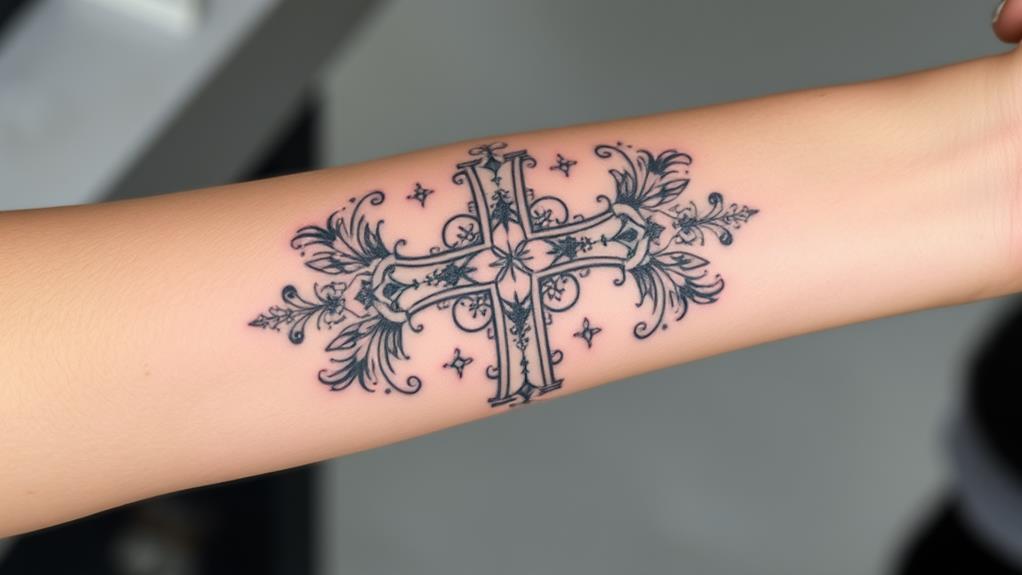Eastern Orthodox Cross tattoos captivate me with their blend of history and artistry. Each design, from the traditional Byzantine cross to contemporary interpretations, bears deep symbolism, embodying faith, resilience, and the human condition. The top horizontal beam reflects divine authority, while the slanted lower bar reminds us of life's choices between salvation and damnation. I'm drawn to both ornate and minimalist styles, each resonating with personal beliefs. Where I place my tattoo—on my wrist, chest, or shoulder—adds another layer to its meaning. There's so much more to explore about these tattoos and what they signify for many of us.
History of the Eastern Orthodox Cross

The Eastern Orthodox Cross, with its intricate design and profound symbolism, has a rich history that dates back to the early days of Christianity.
I've always been fascinated by how this cross evolved over centuries, reflecting the beliefs and traditions of the Eastern Orthodox Church.
Originating in the Byzantine Empire, the Eastern Orthodox Cross features three horizontal beams: the top one symbolizes the inscription, "Jesus of Nazareth, King of the Jews," while the slanted bottom beam represents the footrest of Christ.
As I explore further into its history, I discover that this cross emerged during a time of theological disputes and cultural shifts.
It became a powerful emblem of faith, unity, and resistance against various adversities faced by early Christians.
The cross's adoption by the Eastern Orthodox Church solidified its significance, intertwining it with rituals and liturgical practices.
I can't help but admire the craftsmanship involved in its depiction, whether in frescoes, icons, or even tattoos.
Each representation tells a story, connecting me to a lineage of devotion and artistry that transcends time.
This historical tapestry enriches my appreciation for the Eastern Orthodox Cross, making it more than just a symbol—it's a legacy.
Symbolism and Spiritual Meaning
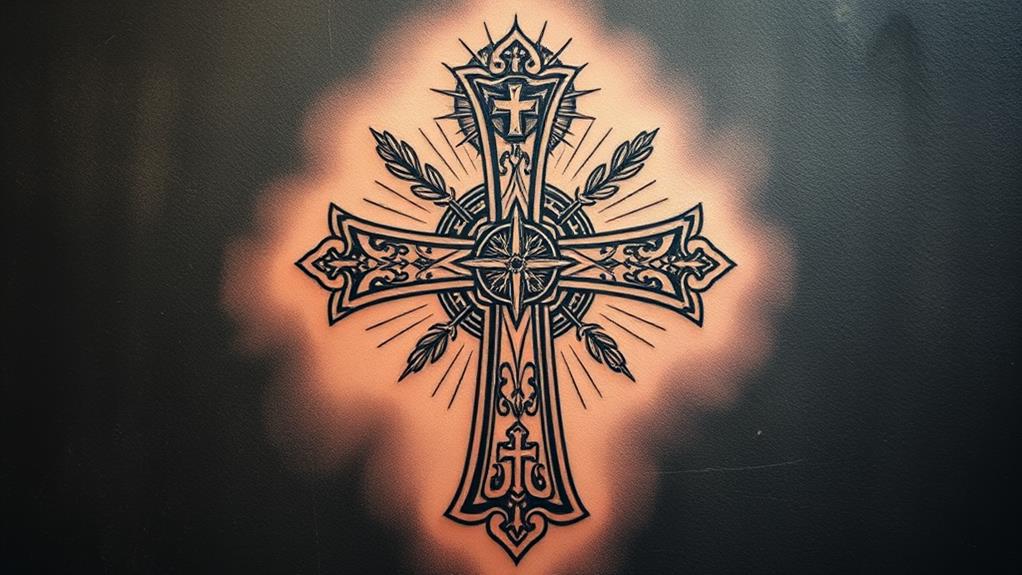
Delving into the symbolism and spiritual meaning of the Eastern Orthodox Cross reveals layers of significance that resonate deeply with believers.
For me, the cross embodies not just the crucifixion of Christ, but a profound connection between heaven and earth. The vertical beam represents the divine, reaching upward toward God, while the horizontal beam signifies humanity's earthly existence.
The slanted bar, often seen in these crosses, is particularly striking. It symbolizes the balance between salvation and damnation, reminding me that our choices shape our spiritual journey.
Each element of the cross is infused with meaning, reflecting the complexity of faith and the call to live a life of virtue.
When I gaze at an Eastern Orthodox Cross tattoo, I see more than body art; it's a declaration of faith, a marker of one's spiritual path.
The cross serves as a constant reminder of sacrifice, love, and redemption. For many, including myself, it's a personal emblem of hope, resilience, and the eternal promise of life beyond death.
This duality of suffering and salvation profoundly shapes our understanding of faith, making the Eastern Orthodox Cross a powerful symbol in our lives.
Traditional Eastern Orthodox Cross Designs
Exploring traditional Eastern Orthodox Cross designs reveals a rich tapestry of artistic expression that reflects centuries of theological and cultural evolution.
Each cross tells a story, often featuring intricate details that convey profound meaning. The most recognized design is the Byzantine cross, with its elongated vertical shaft and two horizontal bars.
The upper bar represents the inscription above Christ, while the lower slanted bar symbolizes the footrest, reminding us of the crucifixion's gravity.
I've always been drawn to the ornate embellishments found in these designs.
Some crosses feature decorative motifs like floral patterns, geometric shapes, or even scenes from biblical narratives. The use of gold leaf and vibrant colors highlights the divine nature of the subject, inviting the viewer to contemplate its significance.
Additionally, the Russian Orthodox cross adds another layer of complexity, often incorporating three horizontal bars and a diagonal one.
This design emphasizes the dual nature of Christ and the hope of salvation. Each variation reflects the local culture and artistic traditions, allowing me to appreciate the diverse expressions of faith that have emerged over time, grounding these tattoos in a rich historical context.
Modern Interpretations and Styles
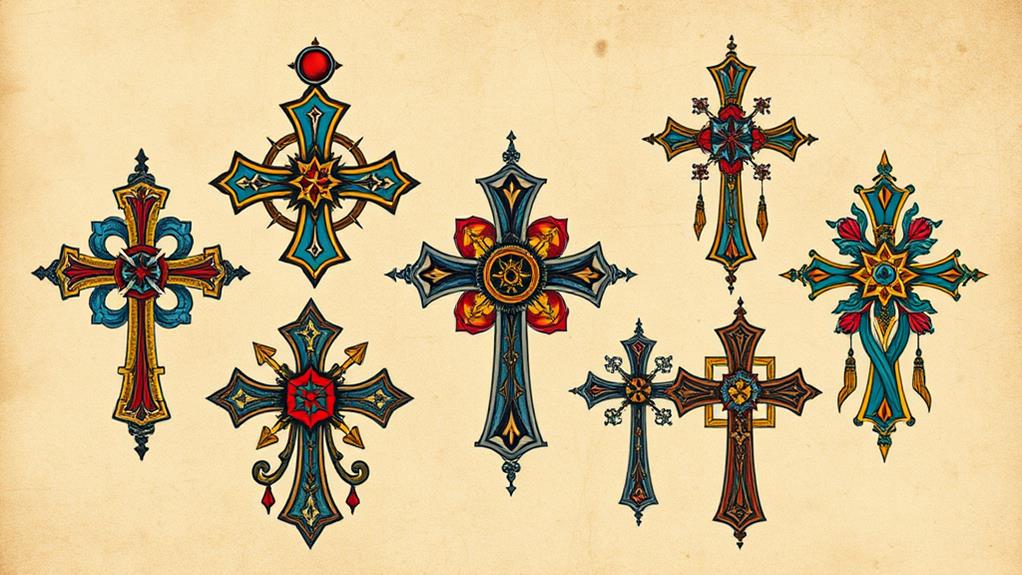
As I explore modern interpretations of Eastern Orthodox cross tattoos, I'm captivated by the rise of minimalist designs that strip away complexity while retaining deep meaning.
I also notice how geometric patterns are influencing these tattoos, offering a fresh, contemporary twist.
Additionally, the vibrant use of color is transforming traditional symbolism, making each piece not just a reflection of faith, but also a bold statement of personal identity.
Minimalist Cross Designs
Minimalist cross designs have emerged as a compelling choice for those seeking a modern interpretation of traditional religious symbols.
I find these sleek, simplified representations to resonate deeply, stripping away the ornate details often seen in classic depictions. The elegance of a minimalist cross lies in its ability to convey profound meaning through basic forms.
When I look at these tattoos, I see a range of interpretations, from a single line forming a cross to subtle variations that incorporate negative space.
Each design feels intentional, allowing the wearer to express their faith while embracing contemporary aesthetics. I appreciate how these tattoos can blend seamlessly with various styles, whether placed on the wrist, shoulder, or even behind the ear.
The beauty of minimalist crosses is their versatility; they can be adorned with delicate dots or lines that hint at deeper symbolism without overwhelming the design.
I've noticed that many wearers choose muted colors or even black ink, enhancing the understated elegance. Each tattoo feels like a quiet statement of belief, a modern declaration to faith that resonates with simplicity and clarity.
In a world full of noise, minimalist cross designs offer a serene, powerful expression of spirituality.
Geometric Patterns Influence
The integration of geometric patterns into cross tattoos brings a fresh perspective to traditional designs, pushing the boundaries of expression while maintaining spiritual significance.
I've always found that these patterns infuse a sense of modernity, transforming the sacred into something that resonates with contemporary aesthetics.
Lines and shapes weave together, creating intricate designs that evoke a sense of balance and harmony.
When I explore geometric influences, I notice how they can simplify the cross while enhancing its visual impact.
The intersection of sharp angles and curves adds depth, allowing the tattoo to take on a multidimensional quality.
I often see crosses adorned with tessellations or fractals, symbolizing the interconnectedness of faith and life.
What fascinates me most is how these designs can be personalized; each geometric element can reflect the wearer's unique journey.
For instance, a simple triangle can represent the Holy Trinity, while a series of interlocking circles might symbolize unity.
This blend of spirituality and artistry feels empowering, allowing me to express my beliefs through a modern lens without losing the essence of the original symbol.
Colorful Symbolism Trends
Vibrant hues breathe new life into Eastern Orthodox cross tattoos, transforming them into dynamic expressions of faith and individuality.
As I explore this colorful trend, I notice how artists infuse traditional designs with a modern twist, using vivid colors to convey deeper meanings. Rich blues symbolize divine protection, while radiant reds evoke the blood of Christ and sacrifice.
Each shade tells a story, creating a visual language that resonates with believers and tattoo enthusiasts alike.
In my own experience, I've seen how these tattoos can blend various styles, from watercolor techniques that mimic brush strokes to intricate dot work that adds texture.
The interplay of color not only enhances the aesthetic appeal but also allows for personal interpretation. I've met individuals who choose specific palettes that reflect their cultural heritage or personal journeys, making each tattoo uniquely theirs.
Moreover, the rise of customization means I can collaborate with tattoo artists to craft a design that speaks to my spiritual beliefs while expressing my personality.
In this way, colorful Eastern Orthodox cross tattoos become more than mere body art; they emerge as powerful symbols of faith, resilience, and individuality.
Placement and Sizing Considerations
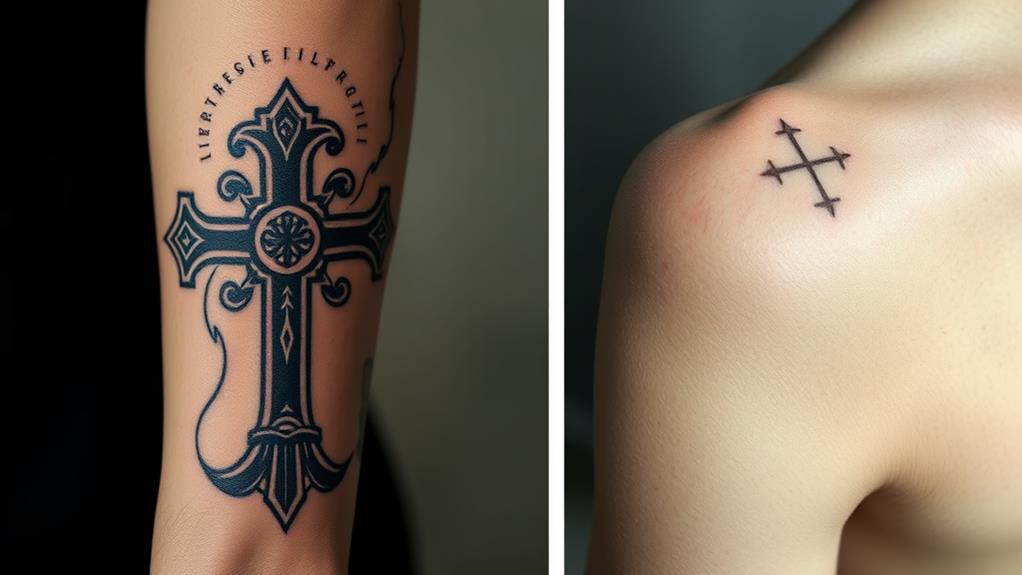
Considering where to place an Eastern Orthodox cross tattoo can substantially impact its visibility and personal meaning.
I've found that the location can reflect my own beliefs, while also influencing how others perceive the tattoo. For instance, placing it on my forearm or wrist allows for easy visibility, making a bold statement about my faith.
In contrast, a placement on my chest or back can serve as a more personal reminder, visible only to me.
When it comes to sizing, I think about the tattoo's intricacy. A smaller cross might lose detail, while a larger one can showcase the ornate designs typical of Eastern Orthodox symbolism.
I've noticed that a medium-sized tattoo works well on the shoulder or calf, balancing visibility and personal space.
Another factor I consider is the pain level associated with different placements. Areas with more flesh, like the upper arm, tend to be less painful compared to bony areas like the ribs or spine.
Ultimately, I aim to select a placement and size that resonates with my spiritual journey while also complementing my body's unique canvas.
Choosing the Right Tattoo Artist
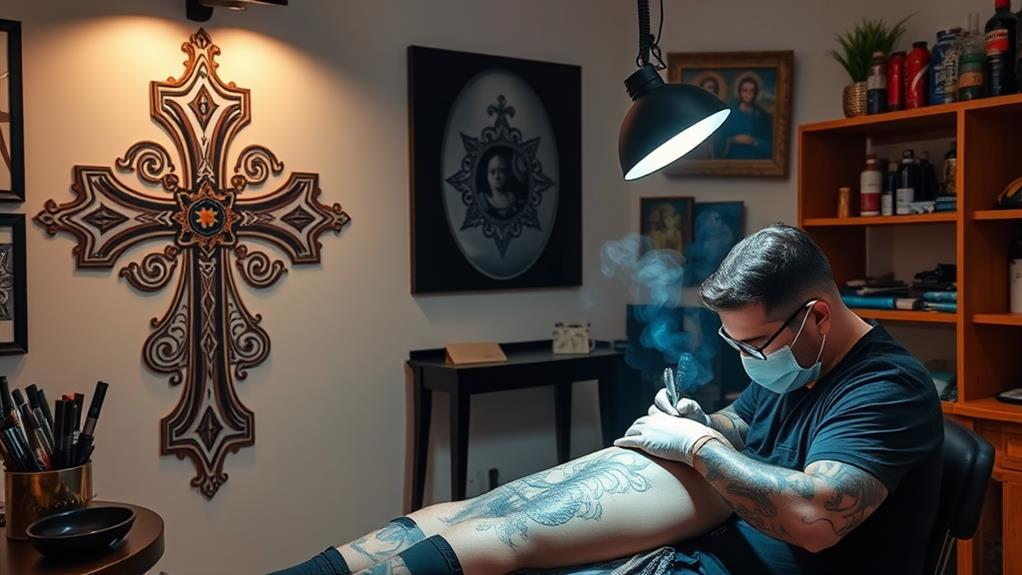
When I started searching for the right tattoo artist for my Eastern Orthodox cross, I meticulously sifted through their portfolios, looking for a blend of skill and style that resonated with my vision.
I found that discussing my design preferences openly helped refine my ideas, ensuring my tattoo would be both meaningful and aesthetically pleasing.
It's vital to connect with an artist who not only understands the essence of your design but can also translate it into their craft.
Research Artist's Portfolio
As I explore the world of Eastern Orthodox cross tattoos, the importance of researching an artist's portfolio becomes crystal clear.
The intricacies of these designs demand a tattoo artist who's not just skilled but also understands the sacred symbolism behind each stroke.
I've learned to focus on several key aspects when evaluating an artist's work.
- Diversity of Styles: I look for a range of designs, from traditional to modern interpretations, ensuring the artist can adapt to different aesthetics.
- Attention to Detail: The precision in line work and shading is vital, especially for intricate symbols like the Eastern Orthodox cross.
- Healing and Aftercare Knowledge: A good artist should provide insights on how to care for the tattoo post-application, ensuring it retains its beauty.
- Client Testimonials: I pay attention to reviews and feedback from previous clients to gauge overall satisfaction and professionalism.
Discuss Design Preferences
Choosing the right tattoo artist for an Eastern Orthodox cross tattoo is a journey that requires careful thought about design preferences.
I've learned that the artist's style should resonate with my vision, whether I'm drawn to the intricate detailing of traditional designs or the bold lines of modern interpretations.
When I sift through portfolios, I pay attention to the precision in line work and the depth of shading.
I've found that artists who excel in religious symbolism often capture the essence of the Eastern Orthodox cross beautifully.
It's crucial to discuss my ideas and see how the artist responds; their enthusiasm and understanding can make a huge difference.
I also consider color palettes—do I want a classic black-and-gray design or something vibrant?
Each choice reflects my personal connection to the faith and the story I want my tattoo to tell.
Finally, I trust my gut.
If I feel a genuine connection with the artist, it usually translates into a more meaningful collaboration.
After all, this tattoo will be with me forever, and choosing the right artist is just as important as the design itself.
Care and Maintenance Tips
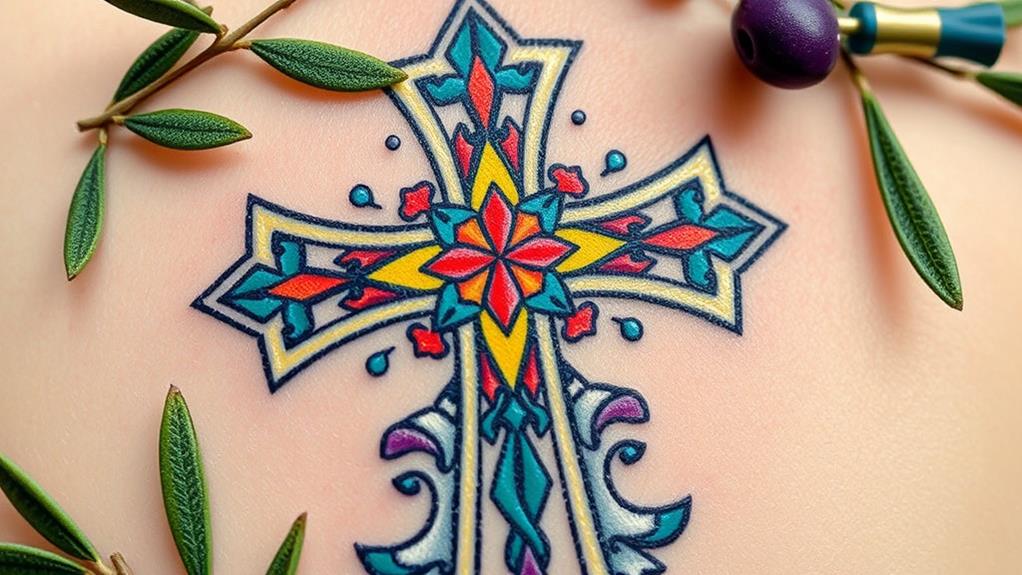
Caring for your Eastern Orthodox cross tattoo requires diligence both during the initial healing phase and throughout its lifetime.
I've learned that proper care not only preserves the vivid colors and intricate details but also guarantees the tattoo remains a meaningful part of my identity.
During the first few weeks, I focus on keeping the area clean and moisturized.
I gently wash the tattoo with mild soap and avoid soaking it in water. After that, I apply a fragrance-free moisturizer or tattoo-specific lotion to keep the skin hydrated.
- Avoid Sun Exposure: Protect your tattoo from direct sunlight, as UV rays can fade the colors over time. When going out, I wear sunscreen with a high SPF.
- Stay Hydrated: Drinking plenty of water helps maintain skin elasticity, which is vital for tattoo longevity.
- Don't Scratch or Pick: If it itches during healing, I gently touch the area instead of scratching it.
- Regular Touch-ups: I schedule touch-ups every few years to refresh the ink and guarantee it looks its best.
With these steps, I keep my tattoo vibrant and meaningful.
Frequently Asked Questions
Are Eastern Orthodox Cross Tattoos Suitable for Non-Orthodox Individuals?
I believe Eastern Orthodox cross tattoos can be suitable for non-Orthodox individuals. They symbolize faith and spirituality, but I'd approach it thoughtfully, respecting the cultural significance while expressing my personal beliefs through body art.
What Colors Are Commonly Used in Eastern Orthodox Cross Tattoos?
I've noticed that Eastern Orthodox cross tattoos often feature deep blues, rich reds, and metallic golds. These colors symbolize spirituality and devotion, creating a striking visual impact that resonates deeply with the wearer's beliefs and identity.
Can Eastern Orthodox Cross Tattoos Be Customized With Personal Elements?
Absolutely, I can customize my Eastern Orthodox cross tattoo with personal elements. Incorporating meaningful symbols or dates transforms it into a unique expression of my faith and journey, making it truly one-of-a-kind and deeply significant.
What Is the Average Cost of an Eastern Orthodox Cross Tattoo?
I've found that the average cost of an Eastern Orthodox cross tattoo typically ranges from $100 to $300, depending on size, detail, and the artist's experience. Crucial to select carefully for quality work.
How Do I Choose a Meaningful Verse or Phrase to Accompany My Tattoo?
When I choose a meaningful verse, I reflect on my life experiences, values, and beliefs. I explore different texts, jot down phrases that resonate, and envision how they'll complement my tattoo's design and significance.
